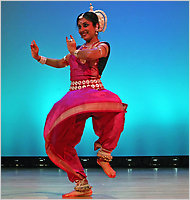
| Festival |
| Festival Schedule |
| Tickets |
| Photos |
| Mission and Goals |
| Festival Video |
| Press Release |
| Call for Submissions |
| Reviews |
| Past Events |
| www.nytimes.com The Subtlety of Gods and Goddesses June 6, 2010 By ALASTAIR MACAULAY |
||||||
The sheer range of dance in New York is as great a marvel as any of the individual high points. Last week I caught DanceAfrica; a modern-dance world premiere; ballets by Balanchine, greatest of ballet choreographers; and the superlative dancing of the ballerina Natalia Osipova. Yet, strange as this may sound, the single performance that seemed the truest revelation of dance itself came in the Indian form of Odissi, opening Erasing Borders: Festival of Indian Dance at the Asia Society.
The Odissi soloist, Shipra Mehrotra, never lifted either foot above knee height. Her few jumps were low and small. A real drawback was that she danced to taped music, as did all of Friday’s performers. And, though Ms. Mehrotra is certainly very fine, I apply no particular superlatives to her. But Odissi itself is a genre capable of exceptional beauty and tremendous scope. A word first on this festival. Like the larger and much older DanceAfrica, the Erasing Borders festival — only in its third year — demonstrates its own ethnic and cultural diaspora. The opening program on Friday night included three traditional forms (Odissi, Bharatanatyam and Kathak), one postmodern dialogue with Kathak tradition, and some all-male Bollywood. As a European outsider I find the Erasing Borders presentations more instructive than DanceAfrica; I come away from them not just having seen a handsome spread of dance but also having learned something about each of the genres on display. Ms. Mehrotra’s excerpt from “Hamsadhwani Pallavi” (choreographed by Padma Vibhushan Guru Kelucharan Mohapatra) was an unbroken stream of variety. Hardly had she begun than her sharp but full-bodied contrast between facing front and facing side was one delight. A continual pleasure was the range (extraordinary outside Asian dance, and nowhere finer than in Odissi) of fingerings in gesture. Each finger can make its own gesture (or combine with individual others), or the hand can become a single brushstroke at the end of an extended arm in motion. Shoulders and pelvis often tilted sideways in opposition, creating a ripple throughout the torso. Further, faster side-to-side ripples sometimes animated the line of the neck. The bare feet (themselves a source of aural rhythm with their bell-laden anklets) kept changing the use of front, heel and sole. Phrases were long, rhythmically intricate and unpredictable, with sudden moments of sculptural balance on one foot. And the eyes play a compelling part. Though some of these factors occur in most Indian dance forms, this “Hamsadhwani Pallavi” was a constantly changing spectrum of them.
In the excerpt of “Ashtapadi: Ramate Yamuna,” the wealth of Odissi mime becomes part of a continuous dance. The program mentions the “range of emotions, from torment to ecstasy, which Radha experiences as she imagines Krishna engaged in love play with another woman,” and Ms. Mehrotra, in a postperformance discussion, described how Radha’s imagination leads her to enact this love-play because this brings her closer to her beloved Krishna. Much of this really was apparent; other gestures of great beauty were unexplained but riveting. She apparently inhales the fragrance of a flower, and her face and entire torso respond deeply. Elsewhere waves pass along her arms. Here, more than ever, the eyes are the focal point of the dance, often intensely watching or addressing another unseen character. This is dance as sustained dramatic monologue, wholly poetic. The erasing of other borders emerged in the discussion. Ms. Mehrotra and Navtej Johar, the Bharatanatyam exponent, both revealed that their choices of dance idiom were not culturally determined. Odissi is from India’s east, Bharatanatyam from its north, but Ms. Mehrotra is from its North and Mr. Johar from its South. So in choosing these genres, they had followed their hearts. Mr. Johar, in particular, spoke of how his very first sight of Bharatanatyam had brought a sense of deep identification. He also spoke, wisely, of the diverse ways in which these dances can be observed. His own solo, an excerpt from “Meenakshi (The Fish-Eyed Goddess),” was about a pre-Hindu mother goddess; he is white-bearded and performed it bare-chested. I watched it entirely as an exercise in style, wholly absorbing in terms of dynamic, spatial, and physical contrasts: fast versus slow, one diagonal versus another, arms, feet, knees, hands, head, eyes, all playing with or against each other. The Parul Shah Dance Company delivered a female trio — an excerpt from “Samanvay” — that concentrated on style. Several moments when the women suggested shapes of ideal geometry, as in ballet, stay in the mind. Cynthia Lee danced and spoke her own punning “Ruddha (Rude, Huh?),” an excessively artful essay in self-conscious postmodern dialogue with Kathak tradition. In “Inspired” the energetic and engaging young second-generation Asian-American men of Wanted Ashiqz brought a Bollywood bonanza, lip-synching while they danced. (Their amalgam of idioms even included a brief, neat evocation of Michael Jackson.) It was easy to overlook how fluently they moved from one formation and image to another, though there is real choreographic skill in these kaleidoscopic changes. I, who know very little Bollywood, was entirely happy. Many people in the audience, evidently knowing their Bollywood much better and laughing in glee, applauded throughout. |
||||||
| Source: http://www.nytimes.com/2010/06/07/arts/dance/07borders.html?ref=arts | ||||||

